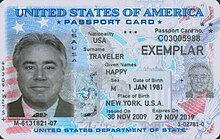United States passport card

The passport card (previously known as the People Access Security Service Card, or PASS Card) is an alternative to a passport created in the United States to meet the documentary requirements of the Western Hemisphere Travel Initiative. Applications have been accepted since February 1, 2008; the cards were made available to the public beginning in July 2008.[1]
Rationale
The passport card is an alternative to a "regular" U.S. passport booklet for land and sea travel within North America (Canada, Mexico, the Caribbean, and Bermuda). Like the passport book, the passport card is only issued to U.S. citizens and nationals. However, the passport card cannot currently be used for international air travel. The Department of State indicates this is because the cards do not meet meet International Civil Aviation Organization (ICAO) document standards.
The passport card is being issued by the United States Department of State in response to border community residents' needs for a less expensive and more portable alternative to the traditional passport book since the Western Hemisphere Travel Initiative's requirements for travelers to carry a single document verifying both identification and citizenship have come into effect. In an effort to improve efficiency at land crossings, the passport card also includes a vicinity-read radio frequency identification chip with a unique identifying number tied to government databases; unlike the passport book, the RFID chip in the passport card is designed to be readable at a greater distance and will not contain any information from the MRZ of the passport card beyond the identifying number. To prevent the RFID chip from being read when the card is not being used, the passport card comes with a sleeve designed to block the RFID chip from being read while the card is in the sleeve.[2]
Under the REAL ID Act, the passport card will also be accepted for federal purposes (such as domestic air travel or entering federal buildings), which may make it an attractive option for people living in states whose driver's licenses and ID cards are not REAL ID-compliant when those requirements go into effect. TSA regulations list the passport card as an acceptable identity document at airport security checkpoints.[3]
Validity and fees
The passport card will share the same validity period as the passport book: 10 years for adults 16 and over, 5 years for children under 16. As of 2008[update], the passport card renewal fee for eligible applicants (adults only, by mail) is $20; first-time applicants and those applying in person must also pay a $25 processing fee, for a total fee of $45. Passport cards for children must be applied for in person; the total fee is $35, including the $25 processing fee.
Adults who already have a fully valid passport book may pay a fee of $20 to apply for the card as a passport renewal.
Individuals may have both a passport card and a passport book, and may use one to apply for the other form of passport (or both) as a "renewal" by mail at the end of its validity period.
Card layout


The passport card is formatted according to specifications for credit-card (ID-1) sized travel documents, as described in ICAO Document 9303, Part 3, Volume 1. The card contains both human-readable and machine-readable information; the latter is printed in the machine-readable zone on the rear of the card as OCR-readable text in the same format as on the identity page of the passport book.
Anti-counterfeiting features
In addition to the embedded RFID chip, the front of the card features a hologram that includes the words "Western Hemisphere Travel Initiative". Three of the six letters in the vertical "USAUSA" to the right of the photograph are etched into the card. On the rear of the card, the "PASSsystem" mark appears in color-shifting ink.
See also
References
- ^ U.S. PASSPORT CARD, retrieved 17 April 2008.
- ^ U.S. Passport Card, retrieved February 5, 2009.
- ^ Driver's License or Passports Preferred ID at Checkpoints, retrieved May 30, 2008.
External links
- Fact Sheet: Western Hemisphere Travel Initiative (WHTI) Passport Card Technology Choice: Vicinity RFID Release Date: October 17, 2006
- Fact Sheet: US Passport Card Release Date: January 8, 2008
